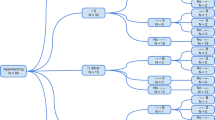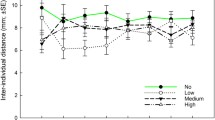Abstract
In Japan, Stigmaeopsis miscanthi (Saito) occurs in two forms that are differentiated by the intensity of male-to-male aggression, i.e. there is a low aggression and a high aggression group (known as the LW and HG forms, respectively). The effects of counterattack behavior against predators were experimentally compared between the two forms. Parental males and females of both forms could achieve significant counterattack success against Typhlodromus bambusae, a specific predator, and counterattack efficiency increased significantly with parental density. Furthermore, the HG form showed a stronger tendency than the LW form to kill predator larvae. Thus, variation in counterattack success may exist between these two forms, and there is some correspondence between male-to-male belligerence and counterattack effectiveness against predators.



Similar content being viewed by others
References
Brodie DE Jr, Ridenhour BJ, Brodie DE III (2002) The evolutionary response of predators to dangerous prey: hotspots and coldspots in the geographic mosaic of coevolution between garter snakes and newts. Evolution 56:2067–2082
Faraway JJ (2006) Extending the linear model with generalized linear, mixed effects and nonparametric regression models. Chapman & Hall, London
Garcia RP, Alejandre RV (1995) Predation upon larvae of the pacific sardine Sardinops sagax by cyclopoid copepods. J Crustacean Biol 15:196–201
Mori K, Saito Y (2004) Nest size variation reflecting anti-predator strategies in social spider mites of Stigmaeopsis (Acari: Tetranychidae). Behav Ecol Sociobiol 56:201–206
Mori K, Saito Y (2005) Variation in social behavior within a spider mite genus, Stigmaeopsis (Acari: Tetranychidae). Behav Ecol 16:232–238
R Development Team (2010) R: a language and environment for statistical computing. R Foundation for Statistical Computing, Vienna
Saito Y (1986a) Biparental defence in a spider mite (Acari: Tetranychidae) infesting Sasa bamboo. Behav Ecol Sociobiol 18:377–386
Saito Y (1986b) Prey kills predator: counterattack success of a spider mite against its specific phytoseiid predator. Exp Appl Acarol 2:47–62
Saito Y (1990) “Harem” and “non-harem” type mating systems in two species of subsocial spider mites (Acari, Tetranychidae). Res Popul Ecol 32:263–278
Saito Y (1995) Clinal variation in male-to-male antagonism and weaponry in a subsocial mite. Evolution 49:413–417
Saito Y (2010) Plant mite and sociality––diversity and evolution. Springer, Tokyo
Saito Y, Sahara K (1999) Two clinal trends in male–male aggressiveness in a subsocial spider mite. Behav Ecol Sociobiol 46:25–29
Saito Y, Takada T (2009) Conditions under which male-to-male aggression compromises cooperation in a game without learning. Open Evol J 3:1–8
Saito Y, Mori K, Sakagami T, Lin JZ (2004) Reinstatement of the genus Stigmaeopsis Banks, with descriptions of two new species (Acari, Tetranychidae). Ann Entomol Soc Am 97:635–646
Sakagami T, Saito Y, Kongchuensin M, Sahara K (2009) Molecular phylogeny of Stigmaeopsis, with special reference to speciation through host plant shift. Ann Entomol Soc Am 102:360–366
Sato Y, Saito Y, Chittenden AR (2008) The parapatric distribution and contact zone of two forms showing different male-to-male aggressiveness in a social spider mite, Stigmaeopsis miscanthi (Acari: Tetranychidae). Exp Appl Acarol 44:265–276
Tsuji N, Chittenden AR, Ogawa T, Takada T, Zhang YX, Saito Y (2011) A possibility of sustainable pest management by introducing bio-diversity––simulations of pest mite outbreaks and regulation. Sustain Sci 6:97–107
Wignall AE, Taylor PW (2009) Alternative predatory tactics of an araneophagic assassin bug (Stenolemus bituberus). Acta Ethol 12:23–27
Zhang YX, Zhang ZQ, Lin JZ, Ji J, Tong L (2001) Larvae and protonymph of the predator Typhlodromus bambusae (Acati: Phytoseiidae) attacked and killed by adult males of their prey, Schizotetranychus nanjingensis (Acari: Tetranychidae). System Appl Acarol Spec Publ 9:11–21
Acknowledgments
We thank Drs. Takenori Takada, Kotaro Mori, Takane Sakagami and Katsura Ito for their valuable comments and suggestions. This research was supported by Grant-in-Aid no. 20370006 for Scientific Research (B) from JSPS and JSPS Research Fellowships for Young Scientists.
Author information
Authors and Affiliations
Corresponding author
About this article
Cite this article
Yano, J., Saito, Y., Chittenden, A.R. et al. Variation in counterattack effect against a phytoseiid predator between two forms of the social spider mite, Stigmaeopsis miscanthi . J Ethol 29, 337–342 (2011). https://doi.org/10.1007/s10164-010-0265-6
Received:
Accepted:
Published:
Issue Date:
DOI: https://doi.org/10.1007/s10164-010-0265-6




